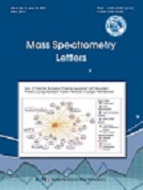
- P-ISSN 2233-4203
- E-ISSN 2093-8950

The high-throughput identification and accurate quantification of proteins are essential strategies for exploring cellularfunctions and processes in quantitative proteomics. Stable isotope tagging is a key technique in quantitative proteomicresearch, accompanied by automated tandem mass spectrometry. For the differential proteome analysis of mouse neuronal celllines, we used a multiplexed isobaric tagging method, in which a four-plex set of amine-reactive isobaric tags are available forpeptide derivatization. Using the four-plex set of isobaric tag for relative and absolute quantitation (iTRAQ) reagents, we analyzedthe differential proteome in several stroke time pathways (0, 4, and 8 h) after the mouse neuronal cells have been stressed usinga glutamate oxidant. In order to obtain a list of the differentially expressed proteins, we selected those proteins which had apparentlychanged significantly during the stress test. With 95% of the peptides showing only a small variation in quantity before andafter the test, we obtained a list of eight up-regulated and four down-regulated proteins for the stroke time pathways. To validatethe iTRAQ approach, we studied the use of oxidant stresses for mouse neuronal cell samples that have shown differential proteome inseveral stroke time pathways (0, 4, and 8 h). Results suggest that histone H1 might be the key protein in the oxidative injurycaused by glutamate-induced cytotoxicity in HT22 cells.
Gygi, S. P. (1999). . Nat, Biotechnol, 17, 994-.
Wilm, M. (1996). . Nature, 379, 466-.
Link, A. J. (1997). . Electrophoresis, 18, 1314-.
Sachon, E. (2006). . Rapid Commun. Mass Spectrom, 20, 1127-.
Gygi, S. P. (1999). . Mol. Cell. Biol, 19, 1720-.
Desiderio, D. M. (1983). . Biomed. Mass Spectrom, 10, 471-.
Richard, D. U. (2005). . Mol. Cell Proteomics, 4, 924-.
Philip, L. R. (2004). . Mol. Cell. Proteomics, 3, 1154-.
Wells, W. W. (2006). . J. Proteome Res, 5, 651-.
Gil-Saeng Jeong. (2010). Neuroprotective Effects of Constituents of the Root Bark of Dictamnus dasycarpus in Mouse Hippocampal Cells. Archives of Pharmacal Research, 33(8), 1269-1275.
Lin, W. T. (2006). . J. Proteome Res, 5, 2328-.
Claire, R. (2006). . Mol. Cell. Proteomics, 5, 68-.
Choi, S. K. (2009). . Biochemical and Biophysical Research Comunucations, 383, 135-.
Bond, C. E. (2006). . Eur. J. Neurosci, 24(2), 381-.
Han, S. P. (2010). . Biochem. J, 430, 379-.
Gygi, S. P. (1999). . Electrophoresis, 20(2), 310-.
Jeremy, E. M. (2006). . Rapid Commun. Mass Spectrom, 20, 904-.
Wang, K. (2010). . Journal of Controlled Release, 09, 10-.
Ha, J. S. (2010). . Brain Research, 1359, 291-.